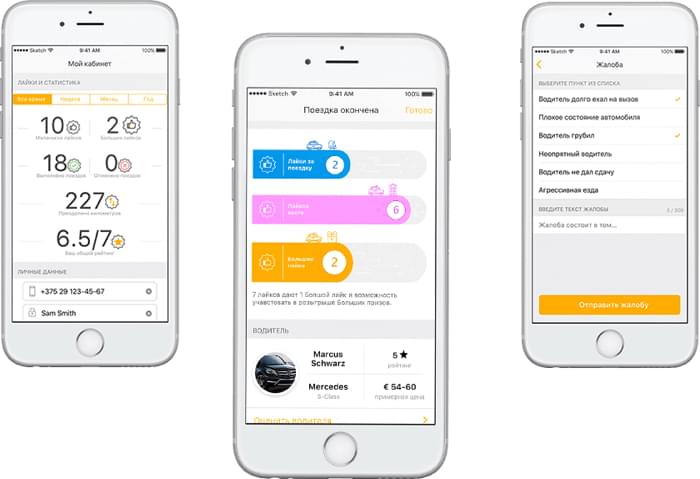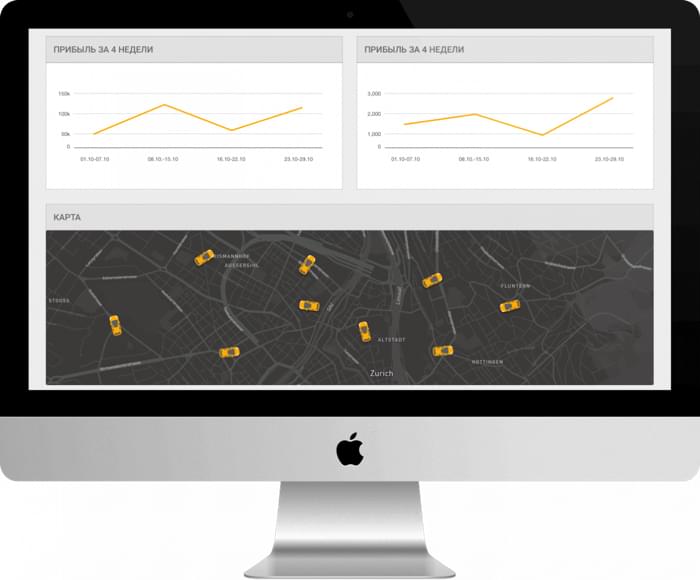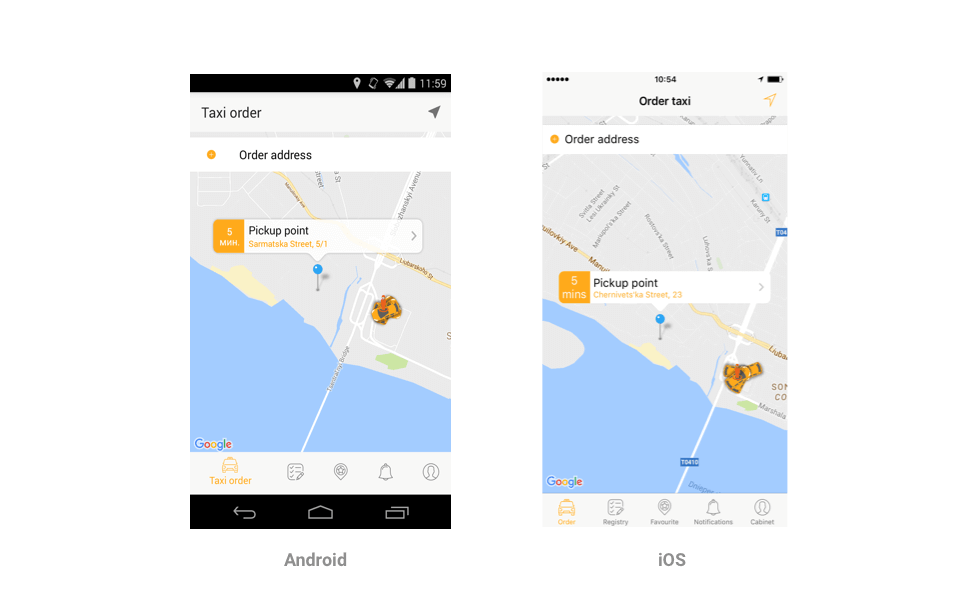In a world where the pace of life is increasingly getting faster as a result of different factors, therefore mobility should be an issue treated as a crucial necessity. Transport companies that are engaged in passenger transportation are aware of this, as well as the fact that a mobile application for a taxi is the best way to ensure customer mobility and help businesses stay afloat. WOXAPP is a company that is ready to help you with mobile app development for taxi business.
Our team has created a similar project “7likes Taxi” for the taxi business in Switzerland. From this experience and after having worked with other geolocation services, we came up with a number of practical tips, so we want our customers to know them before starting a mobile taxi app development.
We have gathered our experience in order to help you to find the answers to the following questions in taxi mobile app development:
- What to start with? What tasks to set?
- How to choose a contractor to ask for taxi mobile app development?
- What platforms to choose: Android or iOS?
- What pay attention to in taxi mobile app development? How not to miss anything important? How not to exceed the specified term?
- What to do with the ready application?
- What questions to ask the contractor?
Let’s work it out step by step.
Who orders mobile taxi app development?
Two types of companies may set their sights on a mobile app developing for taxis: existing businesses (taxi service, fleets of taxis) or startups. Although every taxi business has its own special characteristics, on the whole, a mobile app will provide the following characteristics.
The process of receiving and executing an order does not require the participation of a taxi service.
There is no need to make an order by phone. Reduces the cost of telephone communication.
The passenger does not need to call the dispatcher to call a taxi. The client sees in advance the brand of the car that will come to him, tracks it on the map.
Statistics for each driver: financial calculations, completed routes, the location of the driver in real time, etc.
The customer sees detailed statistics of orders and monitors them in real time, controls the base of customers and drivers. This makes the business transparent and manageable.
How to make a taxi app: The standard structure of the system
Taxi application has been designed to have a three-way structure because they provide interaction between the passenger, the driver and the administrator.
1. Mobile application for passengers
This is the side of the application that allows customers to order a taxi. A set of standard functions includes registration, order form, the ability to track routes, make payments and leave feedback. As usual, the application is downloaded from the market.

2. Mobile application for drivers
The application is also the main working tool for the driver (after the car). With its help, he can see active (inactive) orders, see his statistics, plan his trips according to online maps and react to feedbacks left.

3. Administrative web-panel
The owner of the application (or any other person who has access to the administrative panel) can manage the processes from the inside and track all data coming into the application from both taxi app users and performers.

Admin panel, separate or synchronized with operating CRM, can include:
- An interactive card in order to view the orders online;
- Functions of control and managing: moderation of orders, examination, and permit to work of new drivers or logging out, complaint processing etc.
- diagrams and tables in terms of customers/drivers: which cars are available, how many orders are received/performed, distance measuring, payment etc.
Admin panel can also:
- Have different levels of access to the information for the dispatcher and the owner (partial or complete).
- Specify the access levels in the admin panel. The levels are set for the employees depending on their position and work location. If the service operates in different cities and regions, the access levels of the dispatchers in the regions are the following:
- Gather statistics (day, week, month).
- App screens: priority of choice.
- When the basic and additional functions of the system are identified, the work starts at the app screens and user behaviour scenarios.
Standard architecture of the system
A distinctive feature on such a "tripartite" application, that will be created during the development of a Taxi mobile app is the fact that it will need a backend part. It will work as a server for storing data and sending it directly to the application itself.

Architecture can be roughly divided into 4 parts:
- database servers,
- back-end part,
- front-end part (admin panel)
- mobile app.
System elements communicate with each other via API. API is developed together with the whole system.
Work with system load
The main thing that should be taken into account in a mobile taxi app development is the fact that the product should work very fast. This is one of the distinctive features of all on-demand app - the users need to get their wish come true as quick as possible. So, the system should be able to seamlessly work and be bugs-free.
The second important issue we should foresee in taxi mobile app development is the way the system work in the peak loads conditions. These are the situations when the demand for taxi services increases several times almost instantly, for example, when the weather is bad or during holidays.
The following should be done during taxi mobile app development:
- Lay the proper architecture on the server. What data in which tables to store, the structure of queries to databases, what data will be most often used, and what not.
- Determine the maximum load for your system. The taxi service in the city has 100 thousand inhabitants and services of national scale - different loads.
- Choose a list of technologies used in taxi mobile app development which withstand the load and the requirements for speed (databases, programming languages, etc.)
- Select and configure the appropriate servers in the desired region. Half the time depends on the response time of the server.
- During the taxi app development phase, carry out stress testing. Test the system at the planned peak.

That’s why we use the queue and caching servers in taxi mobile app development, build in the right architecture of storing data, customize a server to perform these tasks and conduct load testing.

Synchronization with existing systems
Do you use existing services and are not going to do away with them? Think through the process of synchronization with the mobile app.
They can be accounting systems, CRM-systems, VoIP, ready systems for taxi services etc. Synchronization is performed by operating the existing API or via developing the new ones.
Provide the developer with the requirements for synchronization before the taxi mobile app development starts.
How is taxi app development carried out?
Determine which functions a taxi mobile app will have. For this purpose:
- collect the requirements from the departments which will be affected by the system implementation
- select the programs which will have the synchronization
- decide what way you will be operating the data
- choose the platforms for which the app will be developed (usually, it’s Android and/or iOS)
- think through all the system elements and specify them.
Taxi application screens: sequence of selection
In the first place, a customer is required to input a number of parameters from the main ordering options.
- Specification of address, from where and required destination.
- What time and what car is required (what time the passenger shall be at the station).
- Taxi order button.
- Calculation of the approximate price and time of the car arrival.
- Brief and clear comments to the order shall be shown in the blocks: search for a driver, will be available in 5 minutes etc.
The following can be hidden:
- Driver’s rating and reviews about the trips.
- Customers’ requirements (special child seat, non-smoking driver, language of communication).
- Method of payment.

Why and what analytic systems to install when your taxi app solution is ready
After the taxi mobile app development process is ended, it is necessary to build in one of the analytic systems. The most popular is Google Analytics, Firebase or systems on a paid basis - Amplitude, Mixpanel, Localytics.
It will give an opportunity to:
- Monitor the events – particular actions of the users in the app.
- Tracking – to see from which site the user installed the app.
- Build in service of collecting crashes (errors, failures) in the app operation and in unexpected shutting-down of the program. As a rule, fabric.io. service is used.

Before the start of taxi mobile app development, determine which indicators you should use to measure a mobile app for a taxi
They are installed individually for each project and mainly answer the following questions:
- how much the company earns;
- how much it spends on attracting clients;
- how the clients use the app.
For taxi services, there can be the following parameters:
- Profit received from the app.
- Trip distance.
- Average check.
- Number of active users a month.
- The indicator of how many users missed the “flow cup” of the taxi ordering. For example, a user chose the direction but didn’t press the “Order” button.
What else to keep in mind during taxi app development?
Build a feedback function in the taxi app.
Complaints and offers will be coming to the mail, so they will be fast responded. If such function doesn’t exist, the reviews will be left on the app stores. Negative comments on the app page can decrease the conversion and affect the search results.
Push Notifications.
It’s a vitally important element for a taxi. Service notifications – about a new order, about a just arrived car – will be entering via push notifications.
Introduce a possibility to estimate an app on a scale of 1 to 5. It affects the search results and product rating.

Which platform to choose: iOS or Android to create a taxi application?
Select the one which is closer to your audience. Taxi is a mass product. In order to keep the customers, we have come up with a taxi app solution for two popular platforms: iOS and Android.
In case you create a service for just one platform, you risk wasting your advertising budget. For example, a person noticed an advert, entered Google Play or App Store, but didn’t find the app.
Here is the example: When the app “7likes Taxi“ was being created, a survey was carried out on what devices drivers and passengers use. It turned out that all drivers with “7likes Taxi” have iPhones, so development of Android app for them makes no sense. However, drivers in the CIS prefer Android devices.
The convenience of interface and app nativeness
The easier, and more understandable the app interface is, the more orders are received and the faster the service is provided. On any screen, a passenger should be guided quickly through the information of how to order a car.

To ensure the apps are convenient and retain the audience, it’s essential to follow the requirements for the design of iOS and Android OS that should be taken into account in taxi mobile app development .
The main task of these requirements in mobile app development is to create a visual language of communication for all the apps of the system. It’s called “nativeness”.
If a customer used a mail app and later downloaded your app, he should find familiar control elements and understand how to use your app.


Design for Android and iOS is different
If we use “7LikesTaxi” as an example, you can see what screens in Android and iOS apps look like. It’s not a whim of a designer, but observance of the recommendations for Android and Apple for mobile app development.


Using non-native elements prolongs the terms of mobile app development. If you want to introduce a non-native element, verify it with the business tasks. Is it cost-effective to extend the deadline because of this function?



Test the application
Test it on real users in order to know for sure whether the apps are understandable for the customer.
1. Conduct a survey of users at the design stage of mobile app development. Office staff or strangers can do the testing. Opinion poll can be held personally or via Skype. You can read about the method in the article “How to develop an interface” tips from a product-designer of Facebook Arthur Bodolts.

2. Perform a so-called “soft” startup. Publish the product and check its performance using a small number of customers.
- There are excellent tools for beta testing in Google Play.
- For iOS use Testflight tool (you should know the mail of the person who you are going to send the app to).
3. In Google Play you can test the graphics, icons, description using “Experiments” tool. A/B tests on your store listing.
Collected estimates and reviews will help to find and eliminate the errors and improve the product, as well as facilitate mobile app development.
Taxi mobile app development cost
The cost of mobile app development depends on the amount of working time of the specialists. The more complex the functionality is, the more time the mobile app development will require.
How to make mobile app development cheaper?
If you already use ready-made taxi app solutions, contact the developers. Find out if they have mobile solutions.
Search for the ready-made solutions at the market. It will save you time and money.
Create mobile app development by iterations
It’s cost-effective to perform mobile app development by iterations, i.e. release an app by parts. For example, the first options of the taxi order: the directions, mapping the route, cost calculation. These are more important as they form the basis of the ordering system. Later, operating complaints, crediting bonuses etc. should be added.

In this manner, it’s possible to get feedback from customers, estimate the demand of each block at an early stage in order not to make unnecessary delays.
Take into account the cost of promotion and support in addition to the mobile app development
In order to attract an audience (passengers and drivers), it’s essential to draw up a marketing budget to promote the app in addition to the mobile app development cost.
A specific feature of the taxi app is that before attracting passengers you should involve drivers.
Beside standard methods of advertising (context, banner, social network advert etc.), become familiar with ASO-promotion. It’s a type of advertising which is created specially for mobile apps.
You will have to draw up a separate budget for promoting and supporting the product in addition to the mobile app development, where there should be expenditure items for evolution and support, payment for hosting service and server rental, payment for publishing on Google Play and App Store.
It’s important to develop and update the mobile app after the startup for various reasons:
- to take into account the incoming complaints and proposals from the users
- to eliminate critical errors
- to add up new functions etc.
How to choose a contractor to develop a taxi solution?
Having chosen a mobile development company, get to know its portfolio performance and recommendations:
- Does the company have experience with similar developments?
- How do they perform the mobile development process? How can you control it? More details about how the mobile development process is carried in our company.
- What will you get from the developer in the end: a ready project, a source code, documentation package? Will they choose the MVP functionality for you?
- Does the company help in publishing the app?
- Looking for a partner in mobile app development? find out what technologies they are planning to use in the mobile development process.
- The essential thing you should understand is the loyalty of the development team to your wishes and financial possibilities.
- What will be the cost of the technical support after mobile development is finished.
Taxi app publishing
Ready-made taxi apps, both driver’s and a customer’s, can be published on special shops within Google Play and App Store after mobile development is finished. For this purpose you should:
- Prepare publishing materials (an icon, screenshots, description, keywords).
- Pay annual fee for the account registration.
- Check whether the product meets the regulations and requirements of the markets (Google Play regulations, AppStore regulations).
- Upload the apps on Google Play and AppStore and send them for verification.
Taxi mobile app is a complex client-server program. We tried to describe the key moments which should be taken into consideration during mobile development. The field of mobile development operations is a lot more extensive, and it would be impossible to delve into full detail here.
Are you thinking about developing a taxi app? We are experienced in mobile apps creation and can help you realize your plans for promoting your business. Contact us to find out the cost for mobile development now.















